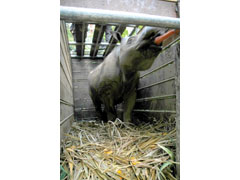
TABIN (Lahad Datu): The only female Sumatran Rhinoceros kept in captivity at the Lokawi Wildlife Park was safely translocated to the Tabin Wildlife Reserve, near here yesterday.
Gelegub, the 28-year-old rhino, is now part of the Borneo Rhino Conservation Programme also known as the Borneo Rhino Sanctuary Programme in Tabin. The aim of the programme is to ward off the extinction of the species which now numbers at less than 50 in the wild.
The rhino underwent a 12-hour journey from the Lokawi Wildlife Park to the Tabin Wildlife Reserve, leaving the park at 6.30pm on Tuesday and arriving at about 6am yesterday. She was accompanied by a convoy headed by the Park’s Veterinarian, Dr Roza Sipangkui, staff of the Sabah Wildlife Department’s (SWD) Wildlife Rescue Unit and its veterinarians. They were also assisted by police.
Gelegub has been placed at the Lokawi Wildlife Park for the last three years prior to the move.
Sabah Wildlife Department Director, Dr Laurentius Ambu said that the decision to move Gelegub was made after consulting with rhino experts in the country as well as from abroad.
“The threat of extinction on the rhino is imminent, with less than 50 left in the wild presently and mainly in fragmented forest,” he said.
He said that SWD are working together with the Borneo Rhino Alliance (BORA), World Wildlife Fund for Nature (WWF), Liebniz Institute of Zoo and Wildlife Research and Liepzig Zoo with the effort to rescue the rhinos at these fragmented forest and bring them to the Borneo Rhino Sanctuary (BRS) where they can meet and mate naturally.
The BRS programme is jointly funded by the State Government and Yayasan Sime Darby.
Laurentius also commented that Gelegub is already too old for natural mating.
However, extensive examination has been carried out on her by local and foreign experts and they believe that she would still be able to produce viable eggs which could then be fertilized with the semen collected by the male rhino kept captive at Tabin.
The male rhino presently residing at the facility is known as Kertam. He added that for the fertilization works to take place, both female and male rhinos must be kept close to each other.
Meanwhile, BRS programme coordinator for the Sabah Wildlife Department, Dr Sen Nathan explained that the electroejaculation, ovarian stimulation, oocyte recovery and invitro fertilization as well as production of embryos would be the first of its kind carried out on Sumatran Rhinoceros.
“We will be working very closely with a team of rhino experts from Liebniz Institute of Zoo and Wildlife Research. We hope to carry out this ground-breaking procedure by late November,” he said. He added that risks are involved when carrying out the procedures.
“As with any medical procedures there are always risks. But we will take all important and critical steps to manage these risks. The age factor of Gelegub is our greatest concern. She is an old girl.”
However, with the team of experts that will be assemblying in Tabin for the procedure, Dr Sen said that he is confident the rhinos will be given the best standard of care possible.